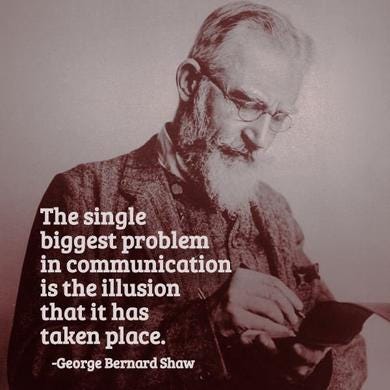Welcome to another edition of “Students of Leadership.”
Today let’s play tricks with the mind.
I am sure that many of you have seen in social media short videos where this concept is applied in various ways. They typically make you listen to a sentence giving you the option of chosing between two words to read on the screen. When you do it, you realize that magically whatever word you chose becomes the word you hear, and if you replay the same video but look or think of the other word, that becomes now the one you hear. And you can switch back and forth always listening to a different word despite the audio being the same.
Take just a minute and watch / listen to the video below to test exactly what we are talking about in fact with the way the original experiment was done.
Now please listen to it again but do the following:
only look at the screen during the first few seconds, quickly turn your head and keep listening till the end, just don’t look at the screen again.
This way you will realize that the initial sounds (‘ba ba’) never change, if you only listen, but it will change your perception of the sound if you look back at the screen.
The sounds are always “ba ba, ba ba.” There is no “da da” or “va va”
The McGurk Effect
Leadership Perspective
Understanding the complexity of human perceptions is not just beneficial but essential. In 1976, British psychologist and researcher Harry McGurk along with his assistant John MacDonald conducted a test where the speaker’s speech movement and sound mismatched, creating an illusion of sound in the brain of the listener. This is called the McGurk effect, which offers a fascinating glimpse into how easily our senses can be misled.
This auditory illusion, where what we see and hear blend to form a different perception, isn't just a sensory eccentricity; it provides us with a powerful metaphor to reflect on the challenges a leader has to navigate the complex waters of team management and decision-making.
The Deceptive Nature of Perception
At its core, the McGurk Effect teaches us a fundamental truth: our perceptions are not always reliable. Anais Nin, a famous writer of female erotica said, "We don't see things as they are, we see them as we are."
The data, reports and impressions we rely on does not always tell the whole story, therefore a good leader must avoid falling for 'perceptual illusions' and instead embrace a comprehensive approach that considers multiple sources of information, different sources of analysis and a rich debate over formal interpretations.
The Power of Bias in Leadership
"Beware of false knowledge; it is more dangerous than ignorance."
George Bernard Shaw
The McGurk Effect underscores the role of bias in our perceptions, and one of the biggest risk is to fill gaps in the understanding of situations with assumptions shaped by our own biases. A leader needs to actively challenge assumptions and incorporate diverse viewpoints to avoid being misled by his perceptions. This practice is important not necessarily because it can lead to more inclusive and accurate decisions (there’s a trade-off there too), but because it fosters a data driven culture that values critical thinking and heavy debate, and those are good foundations for innovation.
Communication: A Two-Way Street
Effective communication is a cornerstone of successful leadership. Just as our senses can misinterpret signals, so can team members misconstrue a leader's communications. Leaders must ensure that their message is consistent and clear across different channels and verify that their intended message is what's actually being understood.
Embracing and Learning from Complexity
The McGurk Effect is a powerful reminder of the complexity of human cognition and perception. There's rarely a single right answer; rather, many perspectives to consider. Leaders should encourage environments where this complexity is acknowledged and explored, rather than oversimplified. By doing so, they foster an atmosphere ripe for adaptability and continuous learning – key traits in today's ever-evolving business landscape.
Leadership Implications
Communication Strategy:
Understanding the McGurk Effect highlights the complexity of communication. Leaders must ensure that their message is not only clear but also consistent across various channels. Misinterpretations in communication can lead to misaligned goals, confusion, and inefficiency within teams.
Fostering a Culture of Critical Thinking:
Leaders should encourage a culture where questioning and critical analysis are valued. By acknowledging the fallibility of perception, leaders must nurture an environment where team members feel empowered to present differing views or challenge assumptions, leading to a more robust decision-making processes.
Diversity and Inclusivity:
The McGurk Effect demonstrates the varied ways individuals perceive the same stimuli, underlining the importance of diversity in teams. Leaders must recognize that diverse perspectives bring a wealth of experiences and interpretations, which can safeguard against collective blind spots.
Emotional Intelligence:
This phenomenon also touches on the need for emotional intelligence in leadership. Being attuned to the non-verbal cues and emotional undercurrents within a team can help leaders discern the unspoken challenges or issues that might be affecting team dynamics.
In summary,
The McGurk Effect serves as a reminder of the cognitive risks in the decision making process due to the possibility of misinterpretation of data and signals, the overconfidence in one’s perceptions and instincts and the exacerbation of confirmation bias where leaders only acknowledge information that supports their preconceptions. The solution lies first in being aware of these risks and then to actively seek out contradictory information to ensure a balanced view.
Bonus Track: The other side of the metaphor
There is another interpretation of the McGurk Effect as a leadership metaphor for the deceptive nature of perception… and that is to know when to simply close your eyes.
If you recall the video at the beginning, when you eliminate the visual stimuli, the sound goes back to the real one, without distortion. So, keep that in mind, when there is too much going on around you, maybe closing your eyes so that you can just listen what is being said without the distraction caused by other senses is the best solution to regain clarity.
P.S. Before I go, here you have “The Treat,” where I share some of the music that kept me company while writing … Enjoy as you bid farewell to this post
“Lead yourself, Learn to live. Lead others, Learn to Build.”
If you enjoyed reading this post consider subscribing to the newsletter for free, joining the community and sharing your thoughts.






